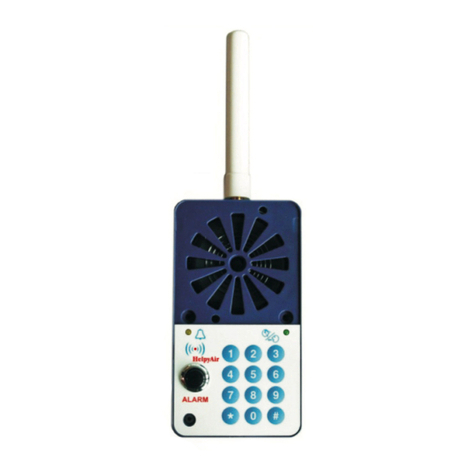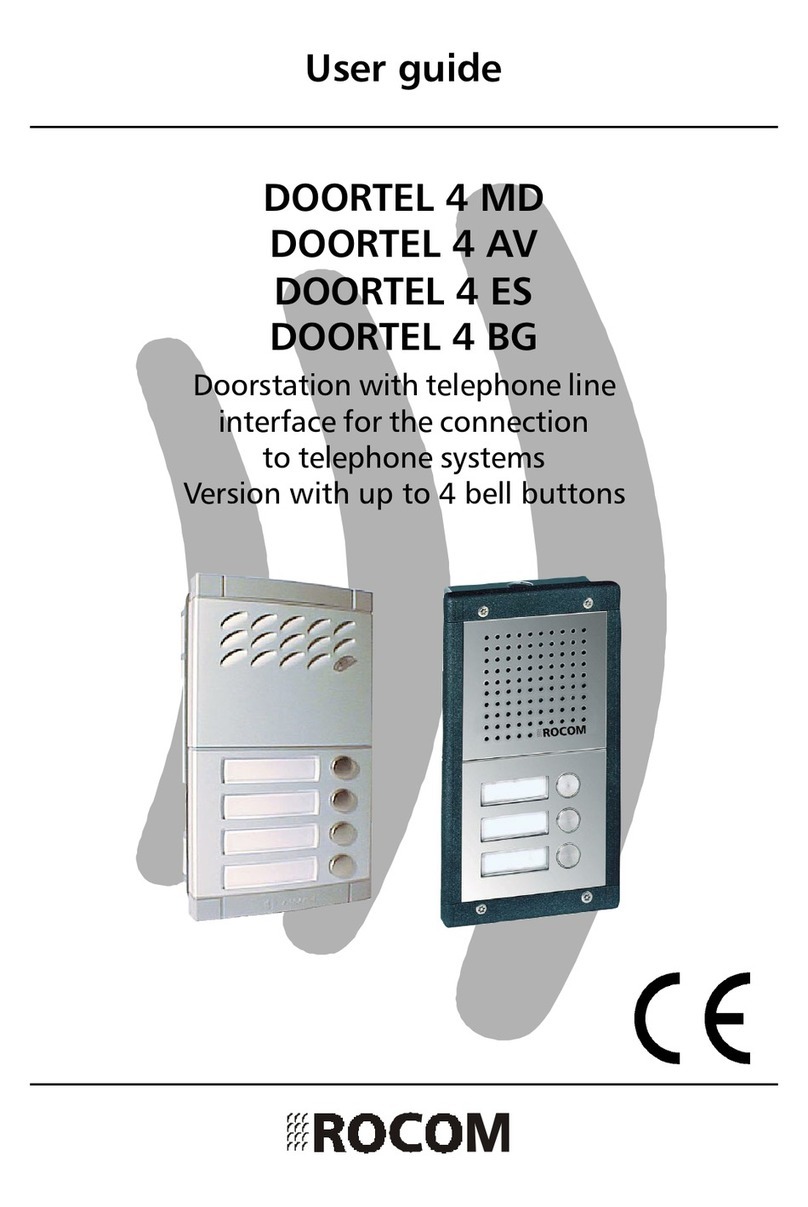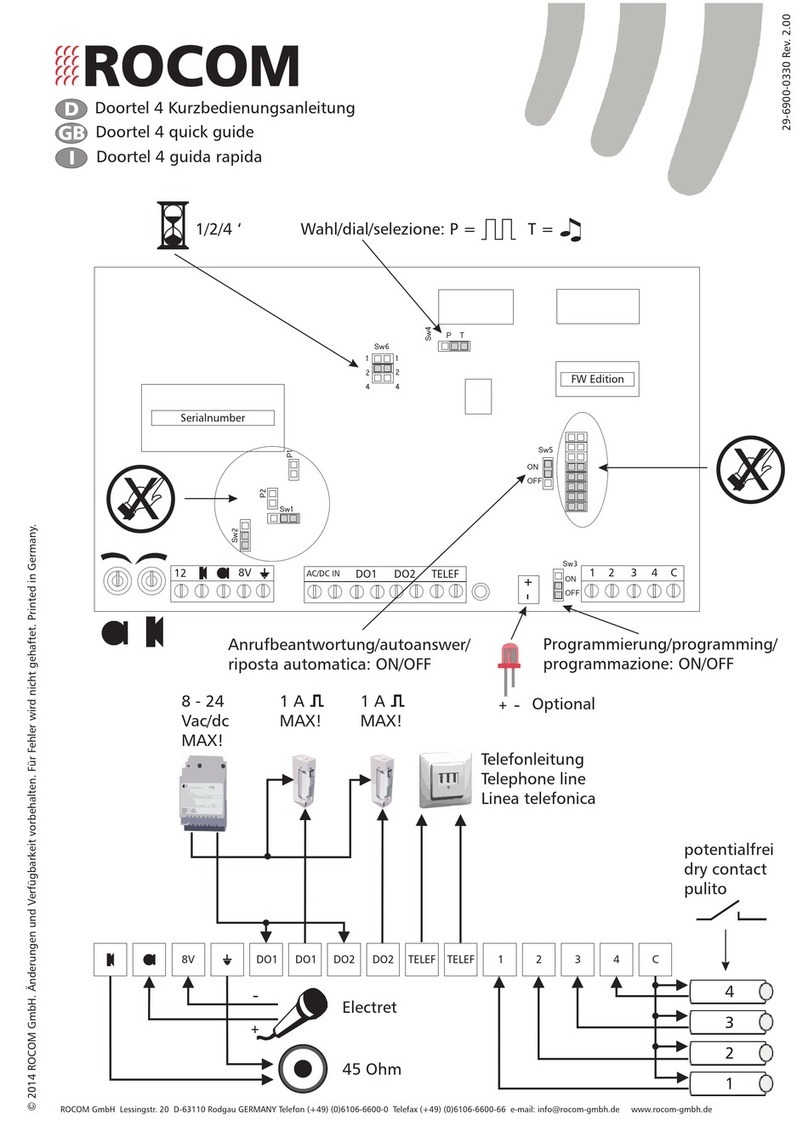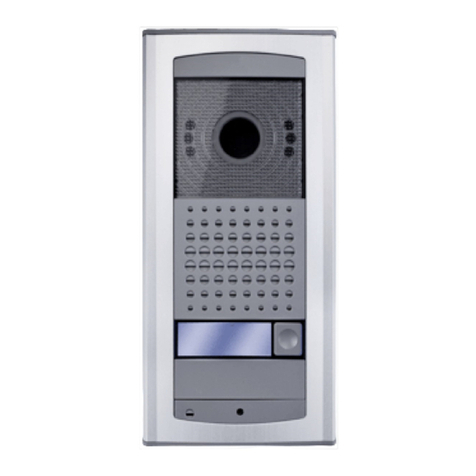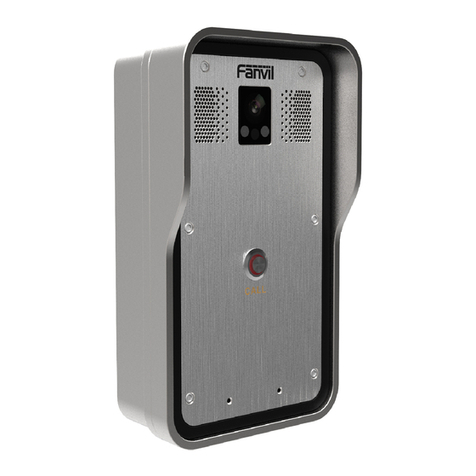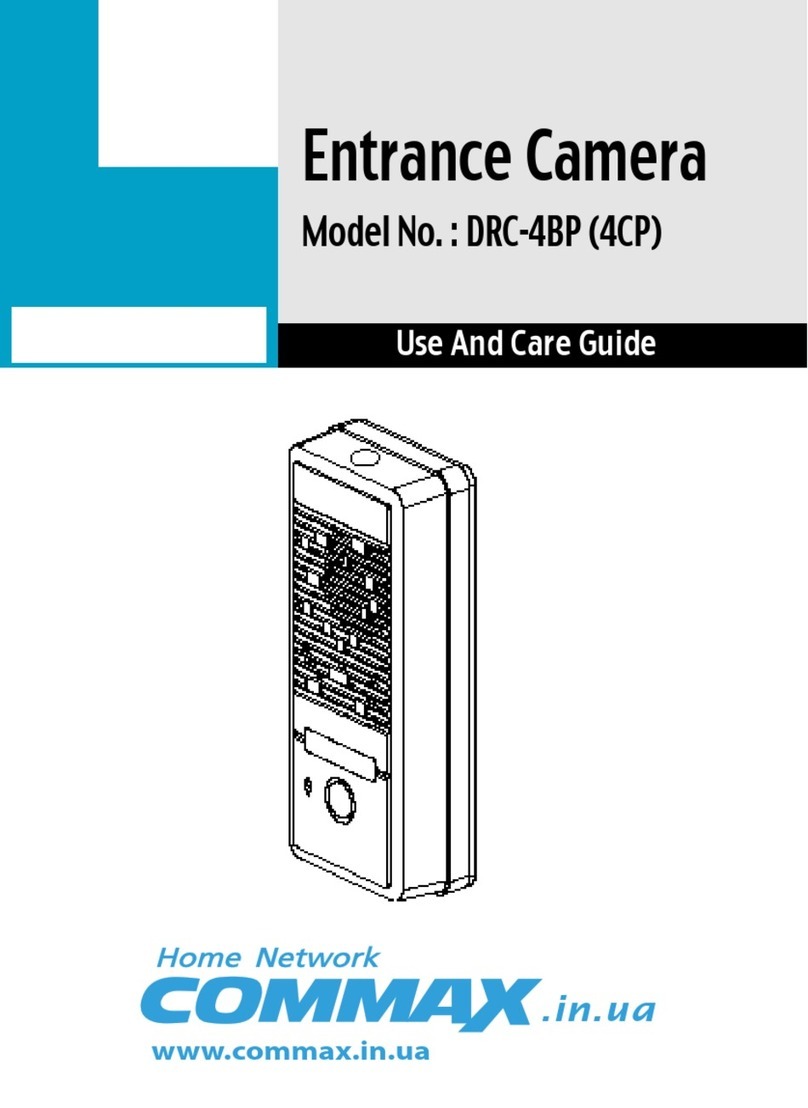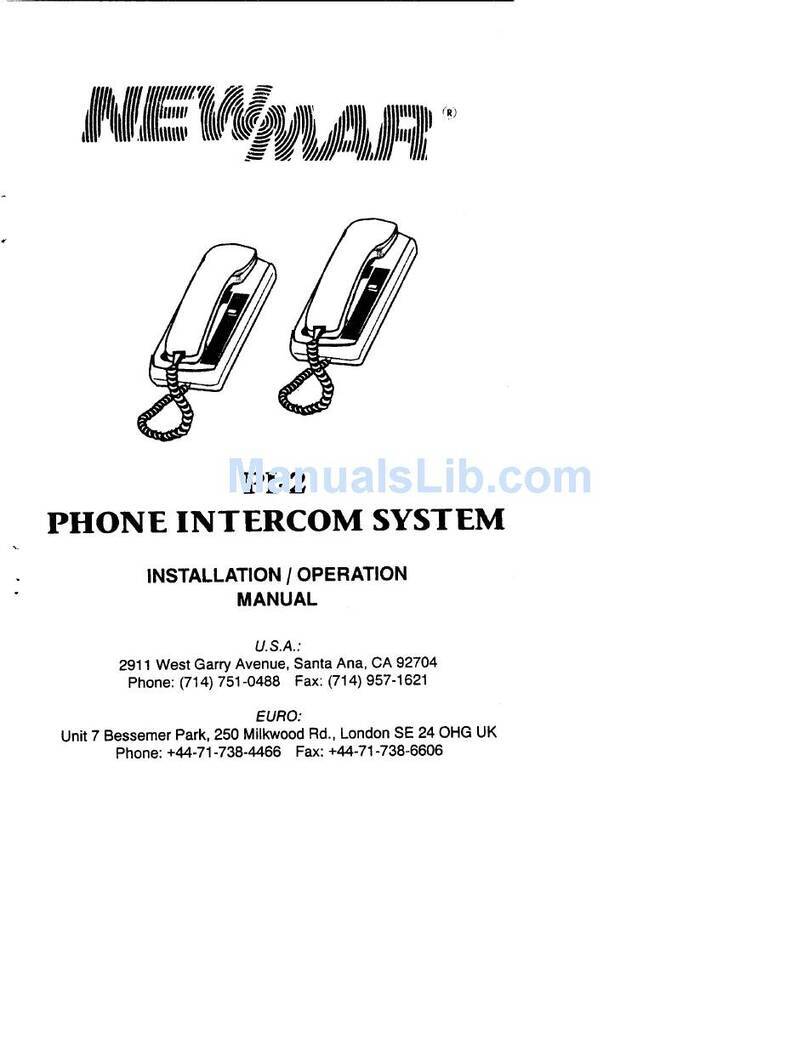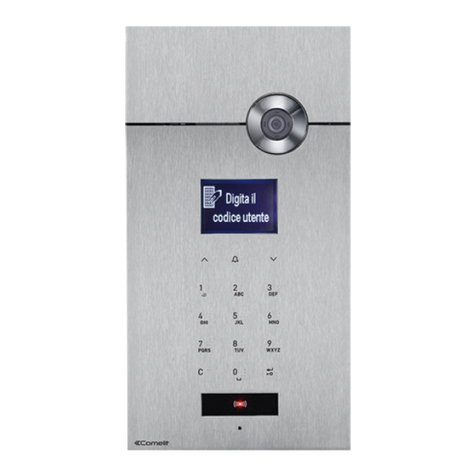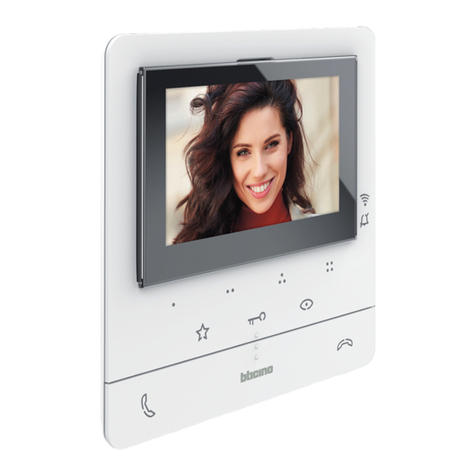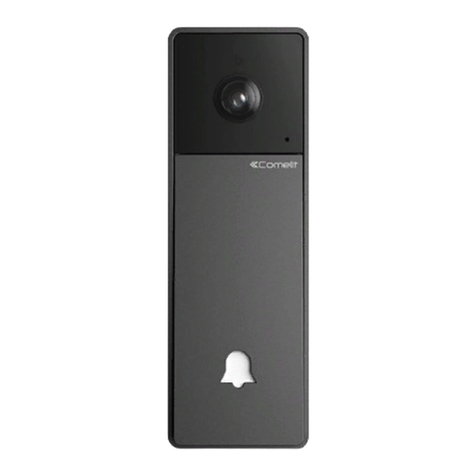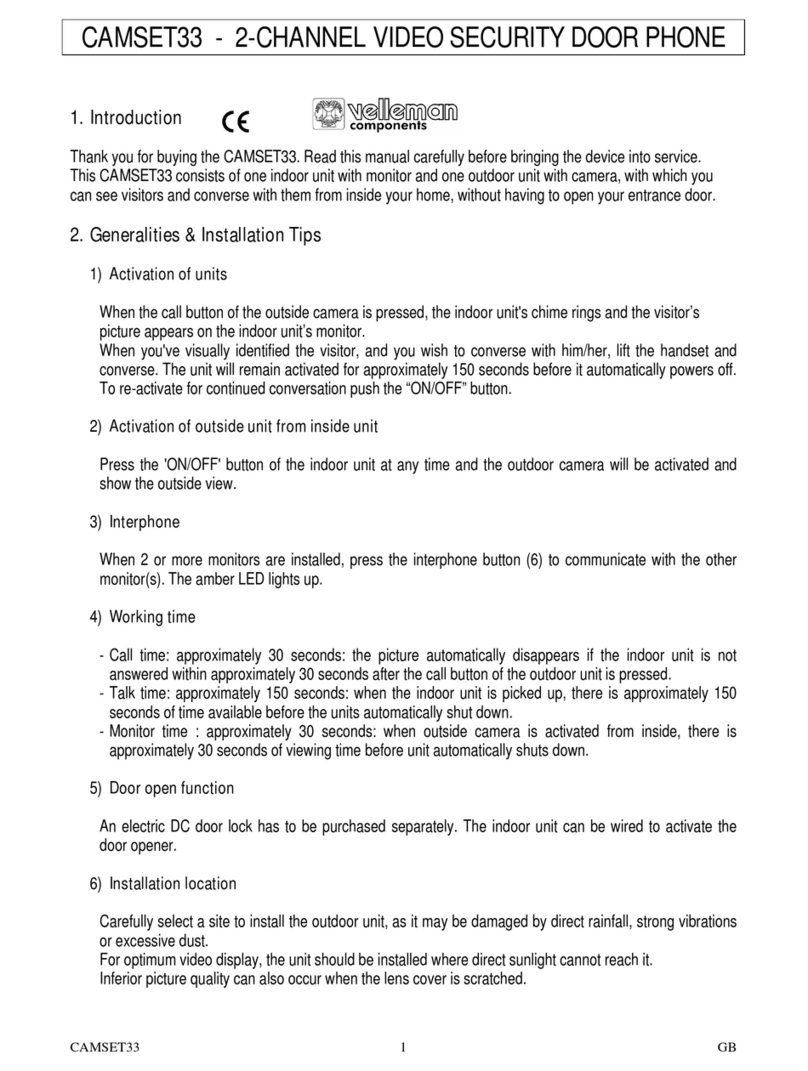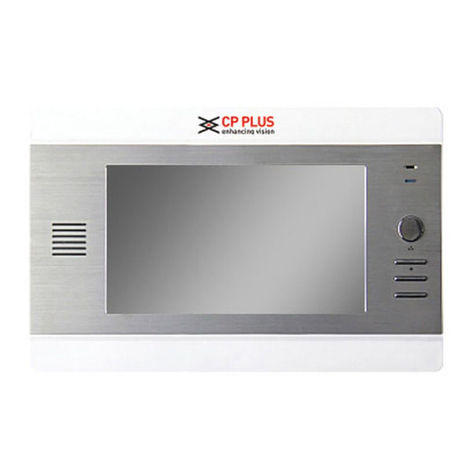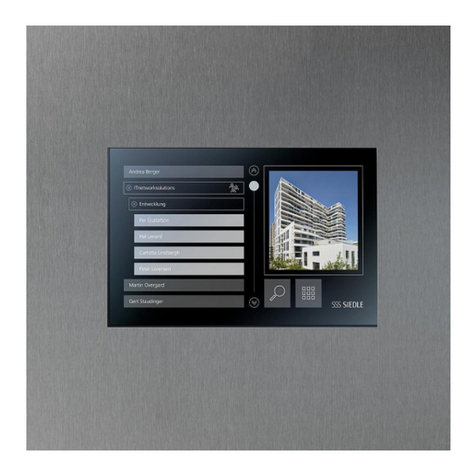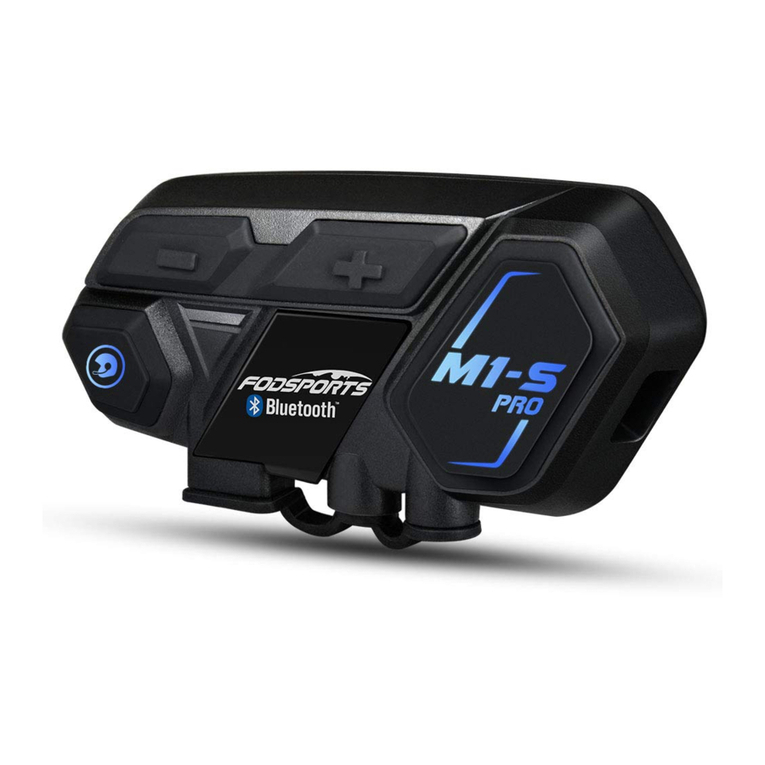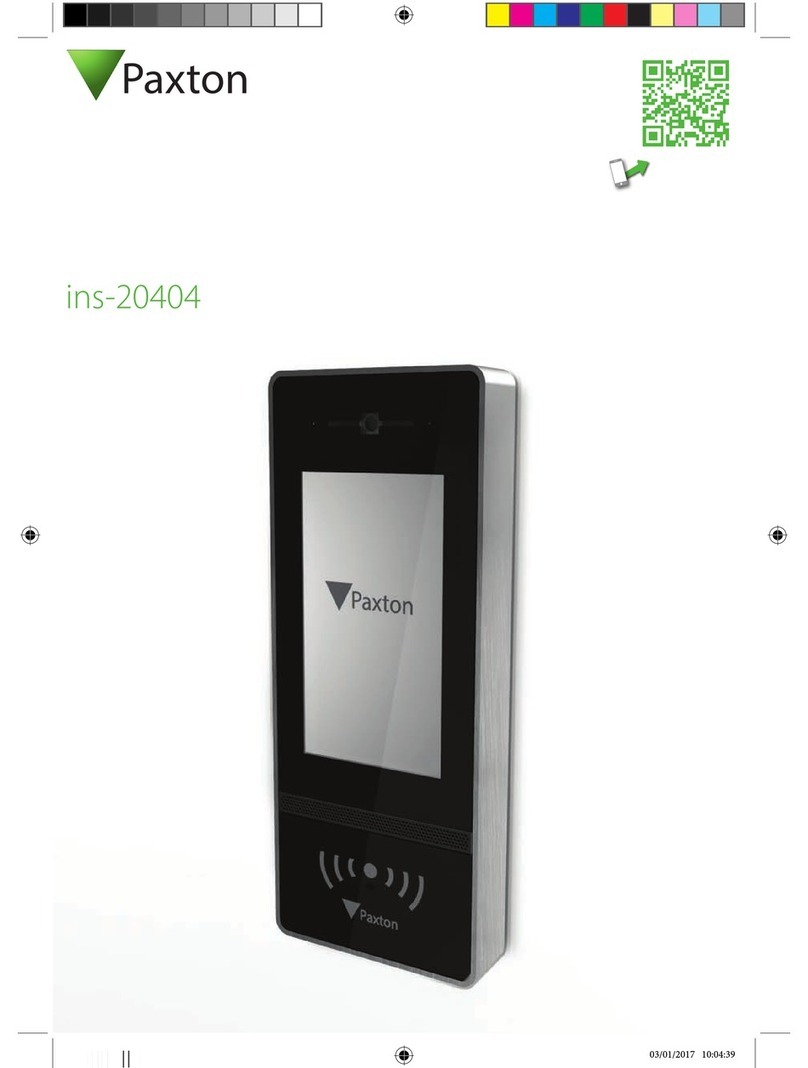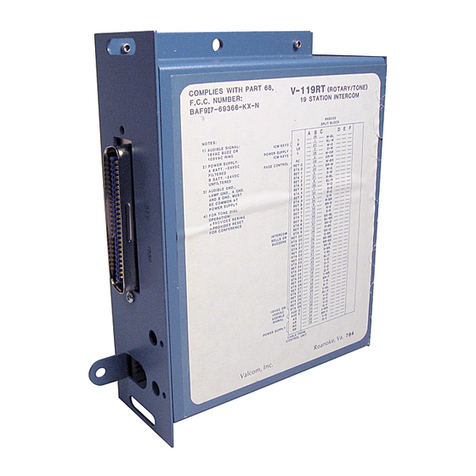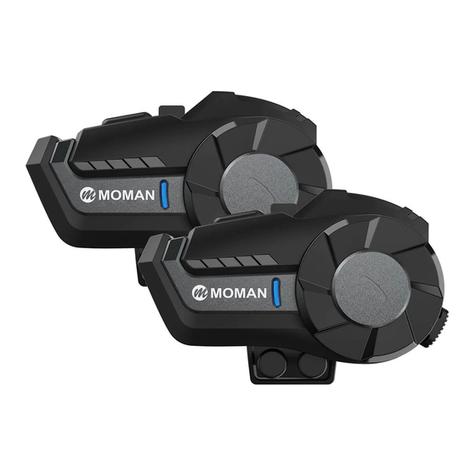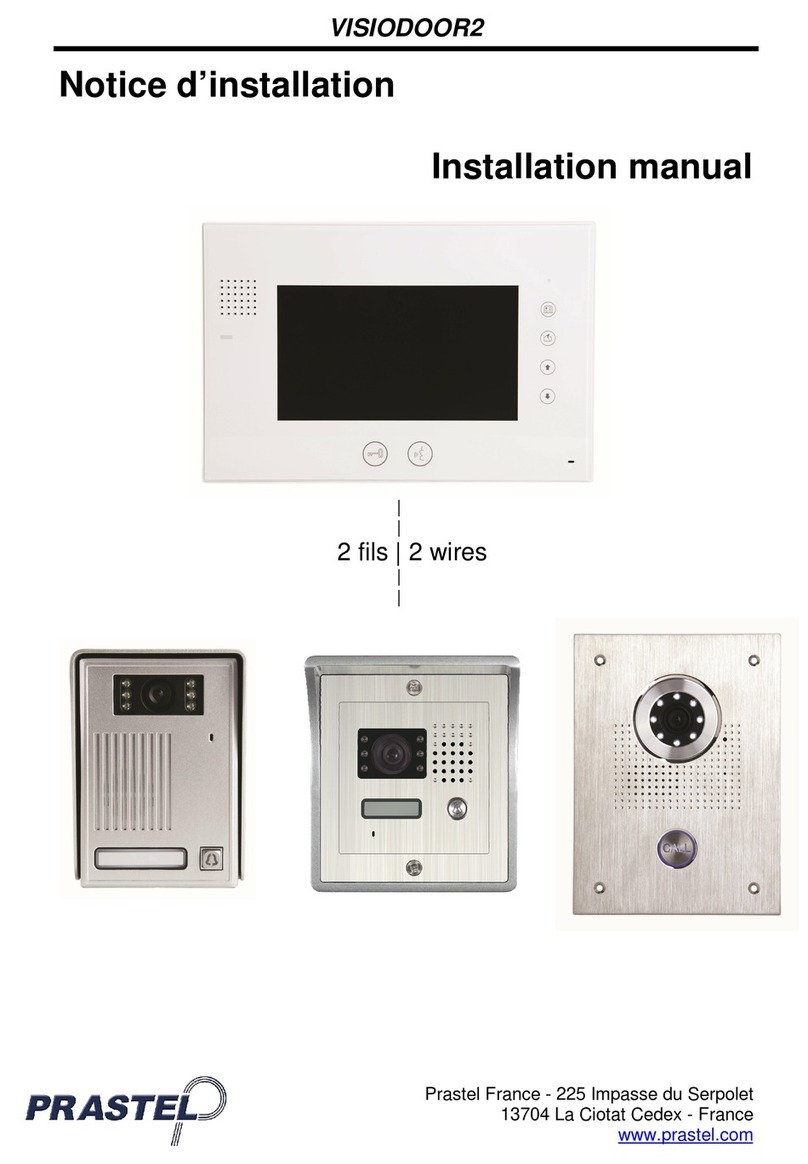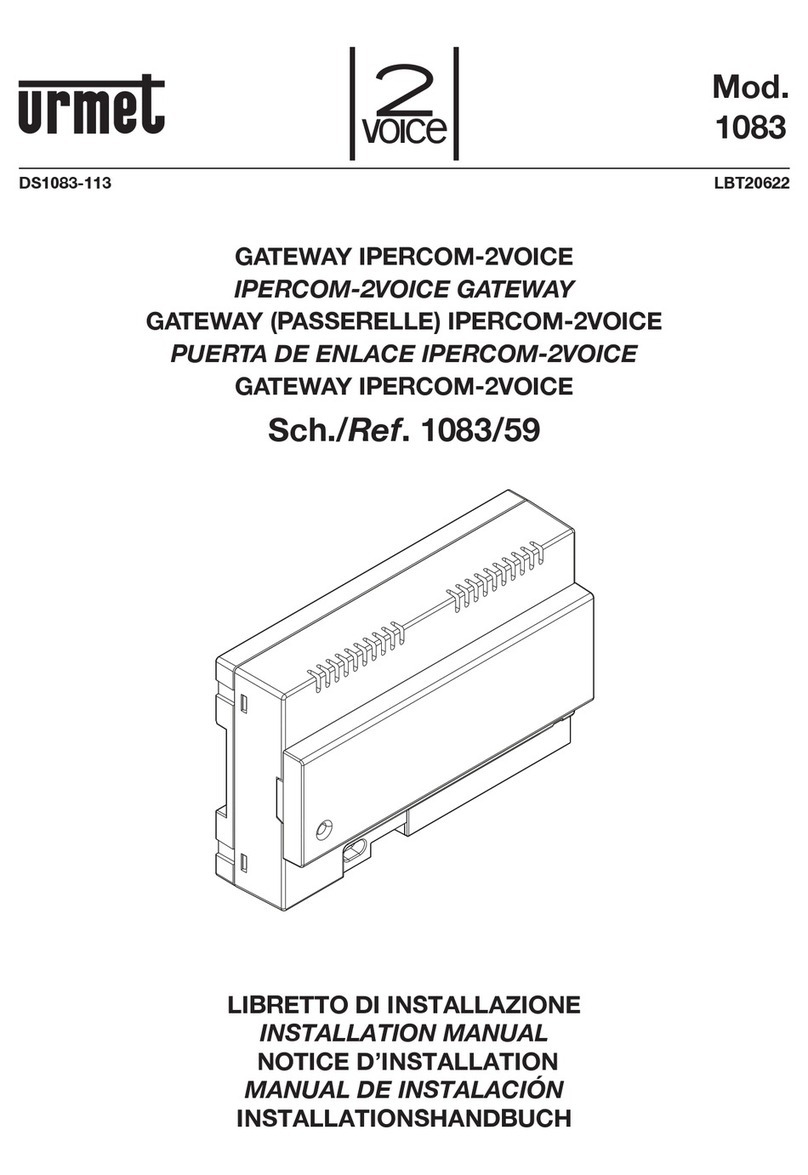Rocom Doortello Business FW T2.05W2.04 User manual

User guideDoortello BusinessIssue 1.00
Page 1
USER GUIDE
Doortello Business
Doorphone with analogue
telephone line interface and
up to 127 chime bottons and
1 dial pad
FW T2.05W2.04 or better

User guideDoortello BusinessIssue 1.00
Page 2
Contents
Introduction .......................................................................................................................................................................... 3
Description ............................................................................................................................................................................ 3
Package content .................................................................................................................................................................... 5
Features ................................................................................................................................................................................. 5
Installation ............................................................................................................................................................................ 6
Security advices .................................................................................................................................................................... 7
Flush and wall mounted installation ..................................................................................................................................... 7
Behind panel installation ...................................................................................................................................................... 7
Cabling of the chime buttons ............................................................................................................................................... 8
Further connectors ................................................................................................................................................................ 9
Telephone line (A/B) ............................................................................................................................................................ 10
RS 485 serial interface (C/D) ................................................................................................................................................ 10
Driver contact 1 and 2 (E/F; G/H) ......................................................................................................................................... 10
External DC power supply (I/L) ............................................................................................................................................ 10
Power supply over the telephone line ................................................................................................................................ 11
Automatic heating element ................................................................................................................................................ 12
Line impedance ................................................................................................................................................................... 12
DB Bus ................................................................................................................................................................................. 12
Volume adjustment ............................................................................................................................................................. 12
First activation .................................................................................................................................................................... 13
Programmation ................................................................................................................................................................... 15
Activate the programming mode ....................................................................................................................................... 15
Tones during programmation ............................................................................................................................................. 16
Default data load ................................................................................................................................................................ 17
Chime buttons and functional keys .................................................................................................................................... 17
Delete telephone number and functional keys ................................................................................................................... 19
Speed dial numbers ............................................................................................................................................................ 20
Delete speed dial numbers ................................................................................................................................................. 21
Automatic call answer ........................................................................................................................................................ 21
Loudspeaker status after line seizure .................................................................................................................................. 22
Microphone status after line seizure .................................................................................................................................. 23
Automatic hang up after driver contact activation ............................................................................................................ 24
Speakerphone operational mode ........................................................................................................................................ 24
Maximum number of digits input from dial pad ................................................................................................................ 25
Password ............................................................................................................................................................................. 26
Access codes ....................................................................................................................................................................... 26
Driver contacts activation codes ......................................................................................................................................... 28
Maximum line seizure time ................................................................................................................................................. 28
Dial pause time ................................................................................................................................................................... 29
Driver contacts activation time ........................................................................................................................................... 30
Interdigit dial pause ............................................................................................................................................................ 30
Keypad activation time ....................................................................................................................................................... 31
Keypad blocking time ......................................................................................................................................................... 31
Blocking time increase ........................................................................................................................................................ 32
Maximum number of attempts ........................................................................................................................................... 33
Flash time ............................................................................................................................................................................ 34
Busy tone detection ............................................................................................................................................................ 34
Ring back tone detection .................................................................................................................................................... 35
Number of rings .................................................................................................................................................................. 36
Tone tables .......................................................................................................................................................................... 36
How to use .......................................................................................................................................................................... 40
Calling a phone using a chime button ................................................................................................................................ 40
Calling a phone using the dial pad ..................................................................................................................................... 40
Calling a phone using a speed dial ..................................................................................................................................... 40
Access code ......................................................................................................................................................................... 41
Direct activation of a driver contact ................................................................................................................................... 41
Incoming call to the doorphone ......................................................................................................................................... 42
Call termination .................................................................................................................................................................. 42
Code digits for the phones ................................................................................................................................................. 42
Optical indicators ................................................................................................................................................................ 43
Trouble shooting ................................................................................................................................................................. 44
Technical data ..................................................................................................................................................................... 46
Programming codes overview ............................................................................................................................................ 47
Overview of programmed values ........................................................................................................................................ 49
Options ............................................................................................................................................................................... 57

User guideDoortello BusinessIssue 1.00
Page 3
The door phone is available as ES version behind a stainless steel plate with holes
for the loudspeaker and the microphone and as BG version as compact unit for
installation inside existing cases like door stations, letter boxes and similar
systems. The construction of the unit ensures an easy installation. The
loudspeaker, the microphone and the controller and all connectors are placed
inside a very small case. This will ensure not only a fast and easy installation, but
also a high level of reliability.
The Doortello Business ES version has been design to be installed together with his
own modular stainless steel door station program. A large selection of different
modules like chime buttons, dial pad, information and frames with boxes for the
flush or surface mounting, as well as pedestals, are available to realise many
different installation solutions. The BG version allows the installation on the back
Description
Introduction
The Doortello Business is a door phone system for integration with new or existing
telephone systems. The door phone has a analogue telephone line interface a can
be connected to any type of transmission technology, as far as a specific adapter is
available, like ISDN, VoIP, GSM, DECT and similar systems. Pressing a chime button,
or dialling a number using the key pad, a programmed telephone number, or the
dialled digits, are sent as DTMF tones to the telephone line. Up to 127 chime
buttons can be connected to the system. Each of them can have a 16 digits long
telephone number stored in the system. When the dialled extension will answer
the call a speech connection is established. A smart tone detection program
ensures that the connection is surely terminated recognizing a busy tone, or in
case of a missing answer after a specified number of ring back tones.
The door phone is approved for the use within the European community as
defined by the 98/482/EU (TBR 21) on the analogue telephone network. This is not
a warranty that the device can work with all European telephone networks, which
might slightly differ from the standard.
If you notice functional problems with your telephone line please get in contact
with your local dealer.
Analogue or digital
telephone
Doortello Business
doorphone PABX
Doortello Business. Functional overview.

User guideDoortello BusinessIssue 1.00
Page 4
Connections
92 mm
100 mm
Microphone Loudspeaker
ES speakerphone. Front and back view.
Volume control
of an existing speakerphone grid, i.e. inside existing old door stations, customer
designed installations, parking house information systems, etc. Using the plastic
adapter frames it is also possible to the install the ES modules in existing letter
boxes or pedestals.
The door phone needs to be connected to a analogue telephone line using two
wires, further the optional external power supply can be use to power the
illumination and the heating element of the unit. The modules of the door station
are connected together using the internal DB bus. Fir the BG version an external
chime button encoding unit is available to connect them to the DB bus. Up to 127
single chime button and a dial pad with 16 buttons (12 for the dial and 4 free
programmable functional buttons) can be connected to the Doortello Business
door phone using the DB bus.
The unit has also two integrated dry driver contacts to command door openers or
other applications, like video cameras. A serial RS 485 interface for the connection
of peripheral expansion units completes the connection block of the device.
The programming of the telephone numbers and all other features are done using
a DTMF dial. A complete description of the programming can be found in the
chapter Programming.
DB BusLine impedance

User guideDoortello BusinessIssue 1.00
Page 5
Package content
The content of the package for the DB 01 Doortello Business BG behind panel door
phone (Part no. 20-2000-0001) includes:
- Door phone with box
- Encoding unit for 4 button with flat cable
- This user guide (german/english)
- Multilanguage short user guide
- Multilanguage user guide for the encoding unit
- Return notice and error description
- Small screwdriver
The content of the package for the DB 02 Doortello Business ES door phone (Part
no. 20-2000-0005) includes:
- Door phone wit stainless steel panel
- This user guide (german/english)
- Multilanguage short user guide
- Return notice and error description
- Small screwdriver
Features
- Up to 127 chime buttons (dry contacts) can be connected. For each button a 1 to
16 digits long telephone number (1-0,*,#, flash, pause) can be stored.
- Dial pad for the dial of telephone numbers, speed dial codes or access codes with
4 programmable functional buttons
- Speed dial for 100 numbers
- Programming using DTMF code with password function (remote programming)
- Programmable driver contacts activation time (0 to 99 seconds)
- RISC processor controlled state-of-the-art speaker phone
- Speech detection
- Programmable ring back and busy tone detection
- Programmable automatic call answer
- Programmable ringing time from 1 to 99 calls
- Volume adjustment for microphone and loudspeaker
- 2 integrated driver contacts with DTMF dial activation (door opener function)
- Programmable door opener DTMF codes
- Programmable automatic driver contact activation with button pressure
- Integrated heater
- Manual disconnection with DTMF dial
- Programmable automatic disconnection after door opening
- Suppression of DTMF tone input from outside
- Connection to a standard analogue telephone line, two wires
- DTMF dial
- Programmable max. connection time fro 1 to 999 seconds

User guideDoortello BusinessIssue 1.00
Page 6
Surface mounted
installation with FLAT
box
Surface mounted
installation with stainless
steel cas and weather
protection
Behind panel
installation
Doortello Business. Many way to install the system
Installation
Installation as
stand alone
pedestal
Before you start with the installation please read the following indications:
- The Doortello Business ES can, together with his modular door station program,
has a IP 55 protection degree and can be installed also outside.
- If you plan an installation in a rainy environment we suggest the use of a
weather shelter or a surface mounting box with weather shelter.
- With surface mounted and pedestals installation we suggest always the use of
the integrated heating element (12 Vdc external power supply is needed). This is
also valid for the BG version.
- If a fluid gets inside the unit disconnect at once the telephone line and the
external power supply (if installed).
- The device can only be maintained by instructed specialized technicians.
- Static discharges may damage the device. Please ensure that you are grounded
before any activity with the unit.

User guideDoortello BusinessIssue 1.00
Page 7
Behind panel installation
The requisite for the installation of the Doortello Business BG version is that there is
already an exiting plate with a speaker grid available. The Doortello Business BG has
been especially developed for this type of use. As the form and technical details of
the plat with the speaker grid may differ from side to side we don’t have the
possibility to provide here precise installation instructions. It is very important that
the microphone is placed precisely in correspondence with a hole to the outside. If
necessary a hole has to be drilled. For a better speech quality of the speaker phone
the unit has installed flush fitted with the plate.
Using the available plastic frame adapters also the ES module can be used for
installation in letter boxes, pedestals and similar installations.
Flush and wall mounted installation
Please read carefully this user guide before you install the unit. Take care about the
security advices. Diregarding the warnings may be against existing laws or cause
dangerous situations.
Please note!
Think any time during installation at your own safety! Be careful and
disconnect the 230 V power supply before connecting the external power
supply unit. Before you touch any cable ensure that no voltage is present on
the line. Please consider that it can be against safety rules to run low and
high power cables in the same duct. An installation of 230 V cable inside the
door station is forbidden by law. If you have to drive high power circuits with
the internal driver contact of the device you have to use external high power
relais (like the 1471, see also the chapter Options)
Security advices
For the flush and wall mounted installation of the device the modular Doortello
Business door station has to be used. This program offers you a wide range of
different flush and wall mounting cases, as well as different pedestals. The
Doortello Business ES device is installed as one of the modules of the modular
door station. The single modules are conneted together using the delivered flat
cable. More details about the installation of the Doortello Business modular door
station can be found in the documentation delivered with the cases and modules.
Please note!
NEVER install a ES version behind an existing panel. This might cause heavy
disturbances to the speaker phone making his use impossible. For behind
panel installation use only the BG version!

User guideDoortello BusinessIssue 1.00
Page 8
Attention! The microphone
must be coincide exactly
with a hole in the plate.
Doortello Business. Behind panel installation
Cabling of the chime buttons
As already mentioned the chime button module are connected with the Doortello
Business ES unit using the flat cable of the DB bus. Up to 32 chime button
modules can be connected. please consider that the last module can have only 3
button. This mean that you can have up to 127 chime buttons connected to the
system.
Each button has a decimal address form 001 to 127. This addresses are allocated
using the DIP swith that you can find on the chime button modules. Each DIP
switch selection allocates 4 fixed addresses for each module. I.e. the frist modul
will have the addresses from 001 to 004, the second one from 005 to 008, and so
on. If the module you are addressing is not fully equipped with all four buttons,
i.e. if you are using modules with 1, 2 or 3 buttons only, you will loose the address
which are not used. I.e. if the first module has only two buttons only the addresses
003 and 004 are used. The addresses 001 and 002 are lost. If the second module
has only 3 buttons only the addresses 006, 007 and 008 are used, the address 005
is lost.
The dial pad module is recognized automatically by the device and for the 4
programmable button, which can be find of the module, for fixed addresses will

User guideDoortello BusinessIssue 1.00
Page 9
Further connectors
Anschlüsse Doortello Business Grundsystem
be assigned: 128 („handset“), 129 („key“),
130 („name“) und 131 („lamp“). Passive
modules, like information, spare or camera
modules don’t use any address.
For the Doortello Business BG the button
encoding module DB 15 is used. Each
module can connect up to 4 dry contact
buttons. Using the DB bus flat cable all
encoding modules are then connected to
the Doortello Business BG unit. As described
above with the chime button modules also
the encoding units are addressed using a DIP
switch, where at each button a decimal
address form 001 to 127 will be assigned.
Up to 32 encoding modules can be used,
where the last one can manage only a
maximum of three buttons. Limitation of the
address use are the same as described above
if not all buttons are used on one encoding
module.
Further information about chime button, dial
pad and encoding modules can be find on
the specific user guide of that products. Chime buttons modules with DB bis cabling
Telephone line (A/B)
RS 485 serial interface (C/D)
Driver contact 1 (E/F)
Driver contact 2 (G/H)
External DC power supply (I/L)
Line impedance 600 Ohm
Line impedance Zr (TBR 21)
DB Bus

User guideDoortello BusinessIssue 1.00
Page 10
RS 485 serial interface (C/D)
External DC power supply (I/L)
Driver contact 1 and 2 (E/F; G/H)
Telephone line (A/B)
The unit must be connected to an analogue telephone line to work. The telephone
line can be a public line, an extension line or the input of a specific FXO adapter for
special networks like GSM, DECT or VoIP. Please take care that the open line voltage
should not be below 20 Vdc and it should be able to delivery a minimum of 18 mA
during the seizure. For the best speaker phone functionality select also the correct
line impedance (read also the chapter Line impedance).
Please note!
The Doortello Business door phone has a „fine“ over voltage protection. This is
useful only if more over voltage protection circuits are installed. If the unit is
installed outside a building we suggest the installation of a over voltage protector
with ground connection on the specific telephone line.
This interface is used for a communication with external devices, like the DB RU 1
unit. This unit has two more relays contacts which can be used instead of the
integrated ones to drive special applications (like TTL signals) or for the remote
control of the door opener if enhanced security is required. The RS 485 interface
can address up to 255 peripheral units.
The driver contacts can be used to open doors or other functions like the
activation of a video camera. As default the first driver contact is activated
pressing the DTMF digit „7“ during the conversation, and the second driver
contact with the digit „8“. Other ways to work are possible, like the automatic
activation with line seizure or after pressing a specific button. Also the activation
codes can be programmed, i.e. to make the door opening dependent from the
input of a code from the telephone. Read also the chapter Programming for more
information.
Please note!
The two driver contacts integrated in the Doortello Business door phone are
dry but not galvanic contacts as they are electronic circuits. That means that
diver voltage below 6 V may not work. In this case (i.e. TTL signals) you need
to use external relays, like the universal relay 1471 or DB RU 1 device (see also
Options for more information).
The optional external power supply is used to power the door phone and to
activate some optional features. The external power supply is needed to activate
the following functions:
- Enhanced amplifier for noisy environments;
- Integrated heating element with temperature control;
- Illumination of the door station modules over the DB bus (max. 12 modules);
- Future enhanced features like speech announcements and display (not available
yet).

User guideDoortello BusinessIssue 1.00
Page 11
The external DC power supply must have a voltage range form 8 to max. 12 Vdc
stabilized. We suggest you the use of the our power supply unit PRS 231S or the
DB RU 1 unit (see also chapter Options).
The external power supply is also used to power the LED illumination of the door
station modules. Using the DC input on the door phone only 12 modules can be
powered over the DB bus. If more modules are installed a separate power supply
has to be used. In this case the door station modules have the jumper which is
used to separate the power line between the modules. For the power supply of
the modules you can find a screw connector on each unit. For more information
please read the specific documentation of the single modules.
Please note!
With installations at sites with extreme weather conditions, as well with wall
mounted and pedestals installations we suggest in any case the power supply
of the door phone to activate the integrated heater element.
Please note!
The external power supply MUST be stabilized. The voltage MUST NOT exceed
12 Vdc. Higher voltage will destroy the unit!
Please note!
If you are installing more door phone on the same site a separate power
supply unit has to be used for each door phone. Connecting more door
phone with the same power supply unit may damage the devices and will
short circuit the telephone lines!
Please note!
The door station modules can be powered also with 12 Vac. Please ensure
that the voltage used does not exceed 13,8 Vpp. A higher voltage may
destroy the modules. If using an external voltage to power the modules
PLEASE ENSURE THAT THE SEPARATION JUMPER IS OFF ON THE FIRST MODULE.
If not applying the external voltage to the modules WILL DESTROY the door
phone!
Power supply over the telephone line
The Doortello Business door phone has been designed to work as well using the
telephone line only. In this case the device is powered by the telephone line itself.
Using the telephone line only the door opener and the modules LED illumination
are to powered separately. In this case only a AC power supply is needed as the
module can power the LED also using a transformer only. Please refer to the
specific user guides for more information.
Please note!
For specific functions, like the dial of a flash signal, the telephone line has to
be interrupted for a short time. To ensure that the processor inside the device
are still powered during this time, if only a power supply over the telephone

User guideDoortello BusinessIssue 1.00
Page 12
Line impedance
DB Bus
The DB bus connectors is used to connect the different modules of the door station
system to the door phone using a flat cable.
Volume adjustment
On the Doortello Business you can adjust the volume of the microphone and the
loudspeaker. If the volume of the loudspeaker is not high enough you can enhance
this by powering the unit (read also the chapter External DC power supply for
more information).
Please note!
Without an external power supply it can happen that with very high
loudspeaker volume and noises (i.e. feed back noise) the telephone line
current not enough is to support the module. In this case the device will
automatically reduce the loudspeaker volume.
For a better sound quality of the speaker phone you need a perfect line impedance
adaptation. The line impedance jumpers is therefore available to select the
impedance of the telephone line you are using. You can choice between 600 Ohm
(default) and Zr line impedance. Which type of line impedance you can normally be
read in the technical documentation of the telephone switch or adapter you are
using. Normally small switches and adapter have 600 Ohm, large switches and
public telephone line (in Europe) have Zr. IF you are not sure which lien impedance
you have just use the selection which gives you the best results.
line is used, a larger capacitor has be installed. This capacitor has to loaded at
the first activation of the device. As the processor can not work until this
capacitor is loaded the unit will take some time as only the idle current of the
telephone line can be used. This is only a few µA and it will take some
minutes time to load the capacitor. If you want to shorten this time you have
to call the device. Please read the chapter First activation for more details.
Please take care that some feature may differ if the unit is externally powered or
not.
Automatic heating element
If the device is externally powered an automatic integrated heating element will be
activated. This is used to ensure a correct functionality with outside temperature
down to - 20°C. The heating element is activated automatically at +10°C and will be
deactivated at +20°C.

User guideDoortello BusinessIssue 1.00
Page 13
Loudspeaker volume
Microphone volume
Doortello Business volume adjustment
First activation
Install and configure the door station as you wish. Ensure that you follow the
instructions of the single modules for a correct installation. Connect the module
together with the delivered flat cable, if needed. Select the correct addressing of
the module as described. After this you can connect the door phone with the
telephone line and the external power supply.
External power supply
- Connect FIRST the telephone line and then the external power supply.
Please note!
The external power supply voltage MUST NOT BE HIGHER THEN 12 Vdc! Check
the voltage using a voltmeter! A higher voltage may seriously damage the
device voiding you warranty! We suggest the use of out PRS 231S power
supply unit.
Please note!
You need a separate power supply unit for each door phone you are going to
install!
Please note!
The connector I/L doesn’t have a polarity. You can connect +/-as you wish.
- After you switch on the power supply the unit will follow an internal start up
procedure. This may take some seconds. If you have a module with LED (like the

User guideDoortello BusinessIssue 1.00
Page 14
key pad module) you can follow the start up procedure sequence as following
described:
- Red LED is on: main processor is activated, the telephone line is checked (voltage,
noise);
- Red and green LED are on: the RISC processor is activated and will be
synchronised with the main;
- Red LED is on: the memory is checked, if no data are stored a default data load is
executed, if data are already stored they will be uploaded from the flash to the
working memory;
- Both LED are off: the device is now ready to work.
Power from telephone line only
- Connect the analogue telephone line;
- Call the unit;
- After a few calls (between 3 and 10) the unit will answer the call;
- The unit will now go through the initialisation procedure as described above;
- An the end the call will be terminated and you will get a busy tone;
- The device is now ready to work.
Please note!
If the door phone is powered from the telephone line only it can happen that
after a power failure or the disconnection of the telephone line that the
device will take some minutes before it will be ready again to work. If you
want to shorten this time you have to go the above described procedure
again. Refer also to the chapter Power supply over the telephone line for
more details.

User guideDoortello BusinessIssue 1.00
Page 15
Programmation
The entire programmation, like storing the telephone numbers or the selection of
the different operating modalities, is done using a telephone with DTMF dial
capability.
Please note!
The device has two memories. A RAM and a flash memory. During the
programmation the unit will transfer all the data from the flash to RAM
memory. At the end of the programmation the data are transferred again
back to the flash. This will be done at one step when terminating the
programming mode using the digit . Pressing this digit you will get a
acknowledge tone, but the unit will disconnect the lien and go back to stand
by only after some seconds. If during this time the line is interrupted or the
power will fail all the data programmed up this point will be lost. If you are
doing a larger programmation we suggest to make a data storage from time
to time.
Activate the programming mode
If you want to program the Doortello Business you to first activate the
programming mode. Before you can program the device it has to be connected to
a telephone line and, if required, to a power supply.
After the first power on of the power supply, or connection to the telephone line,
the device will follow an initialisation procedure. With this process the RAM
memory is deleted and the telephone line checked, read also the chapter First
activation for more information. During this time the device is not available. If you
have a module with LED you can follow the initialisation procedure on the LED.
When both LED are off the device is ready to be used.
Call now the unit using a phone with DTMF dial capability. The device will answer
the call and sent a short tone. The red LED (if installed) will go on and then the
green LED (if installed) on and the red LED (if installed) off when the unit is ready
for speech.
Please note!
It may be that the automatic call answer feature has been deactivated on the
Doortello Business with a previous programmation.
In this case you will hear a ring back tone but the until will not answer the
call. To start the programming mode you have to press during the call one of
the chime or functional buttons at the door station. The device will now
answer the call and you can follow the programming procedure as described.
The programming mode is activated with the following input:

User guideDoortello BusinessIssue 1.00
Page 16
Tones during programmation
During programmation you will hear the following tones:
Answer tone:1 short tone. Is sent when the call is answered and the unit ready
to accept more commands.
OK tone:3 short tones. The data input or command is correct.
NOOK tone:6 short tones. The data input or command is not correct, last data
input is lost.
Error tone:9 short tones. There was an error on the device memory. Data could
not be stored and are lost.
Password (default ) OK tone
Now the programming mode is activated. The red LED (if installed) will go on and
the green LED (if installed) off. The green LED (if installed) will flash with every
positive detection of a DTMF digit.
To terminate the programming mode dial .
Please note!
If you terminate the call hanging up the handset without dialling the digit
all the data inserted up to this time will be lost!
Please note!
It may be that the programming mode activation using a password has been
deactivated with a previous programmation. Is this case the programming
mode is activated just after the input of the digits.
Please note!
The password could has been changed. If you hear a NOOK tone you have a
wrong password.
Please note!
As soon as the device will answer the call a maximum connection timer will
start. This is set as default at a value of 60 seconds. At the end of this time
the unit will disconnect the line. All data inserted until this time will be lost.
We suggest you to change this time if you plan an extensive programmation.
Please note!
When you terminate the programming mode with the digit all
programmed data will be transferred from the RAM to the flash memory. This
will take about 30 seconds. During this time the device is not available.

User guideDoortello BusinessIssue 1.00
Page 17
If you have to move the door phone, to change the complete programmation or
the unit was programmed wrong you can load the factory default data using the
following procedure:
OK tone OK tone
Please take care that the default data load will delete all programmed telephone
numbers and values. If you want to delete or change just one telephone number is
the default data reload not very useful. Use instead the procedure described in the
chapter Delete telephone number and functional keys.
Please note!
The above indicated procedure considers that the password has his standard
value . If the password was changed you have to use the new
password instead of .
Please note!
The default data are loaded only after the input of the digit to terminate
the programming mode.
Please note!
If the password has been lost it is possible the load the default data using a
master password. In this case the factory default data a reloaded as well the
standard password. Please contact Rocom Energie- und Kommunikations-
systeme GmbH for more details.
Default data load
Chime buttons and functional keys
Each of the 127 chime buttons and the 4 functional keys on the dial pad can be
programmed to dial a telephone number with up to 16 digits. Also special
functions can be assigned to the buttons, and sometime also special functions
together with a telephone number can be programmed.
The single chime buttons have a decimal address from 001 to 127. This address is
defined by the DIP switch you can find on the single modules (see also Cabling of
the chime buttons for more details and the user guides for the chime button
modules and the encoder units). The four functional keys on the dial pad have a
fixed address: 128 („handset“), 129 („key“), 130 („name“) und 131 („lamp“).
As digits inside a telephone number you can use all numbers from 1 to 0, as well
the special codes * , # and the functions „flash“ and pause.
From factory no numbers or functions are programmed for the buttons. Only the
functional key 128 („Handset“) has the function „Dial pad

User guideDoortello BusinessIssue 1.00
Page 18
activation for DTMF dial“ and the 129 („Key“) has the function
„Dial pad activation for access code entry“ programmed
from factory as default.
To program the chime buttons and functional keys follow this procedure:
OK tone {telephone number of function} {button address}
OK tone
As digit for the telephone number (max 16 digit for each telephone number) the
following values can be entered:
Digits: , , , , , , , , , ;
Special dial functions: , will dial the code (is considered as 1
digit);
, will dial the code (is considered as 1
digit);
, will make a dial pause of 2 seconds (default
value) duration (is considered as 1 digit);
, will send a „Flash“ (short line interruption,
„Recall“ button) of 80 ms (default value)
duration (is considered as 1 digit);
Functions: , activates the dial pad for a DTMF dial;
, activates the dial pad for the speed dial entry;
, activates the dial pad for a function entry (i.e.
access code entry);
Special functions: , activates the relay 1 after pressing the
button;
, activates the relay 2 after pressing the
button.
Please note!
A function can be programmed only for button where no telephone number
is programmed. After the programmation of a function no more inputs or
programming are possible for this button. A new programmation will
overwrite the existing data.
Please note!

User guideDoortello BusinessIssue 1.00
Page 19
Each chime button and the 4 functional keys on the dial pad can be deleted one
by one. To delete on button please follow the procedure:
OK tone {button address} OK tone
Example:
You want to delete the chime button 5. Input:
OK tone OK tone
Please note!
If you want to reprogram a chime or functional button you DON'T have to
delete it first. The new programmation will overwrite the existing one.
Delete telephone number and functional keys
A special function can be programmed also for button where a telephone
number is already programmed. You can i.e. program a button to dial a
number and in the same time to activate a relay to command an external bell.
Examples:
The chime button 1 must dial the number 13. As your PBX has an automatic
trunk selection feature activated you must dial a flash to switch from external to
internal dial. To ensure the correct dial after the flash a pause has to be inserted.
Programmation:
OK tone OK
tone
This number will use 4 of the 16 available digits.
The chime button 4 must dial the number 15 and activate at the same time
the relay 2. Programmation:
OK tone OK tone
OK tone ,OK tone
This number will use 2 of the 16 available digits.

User guideDoortello BusinessIssue 1.00
Page 20
The dial pad can be use to dial telephone numbers and/or speed dial codes. This
function is free programmable (read also Chime buttons and functional keys
programmation). If needed you can use also both functions programming the
functional buttons on the dial pad or chime button modules. If you select the speed
dial function you can enter a two digits long code on the dial pad. This code will
then dial a up to 16 digits long stored telephone number on the telephone line.
The speed dial codes can be 00 tp 99, this means that you have up to 100 speed dial
locations available.
As digits inside a telephone number you can use all numbers from 1 to 0, as well
the special codes * , # and the functions „flash“ and pause. From factory no
numbers are programmed in the speed dial locations.
To program the speed dial numbers follow this procedure:
OK tone {telephone number} {speed dial code} OK tone
As digit for the telephone number (max 16 digit for each telephone number) the
following values can be entered:
Digits: , , , , , , , , , ;
Special dial functions: , will dial the code (is considered as 1
digit);
, will dial the code (is considered as 1
digit);
, will make a dial pause of 2 seconds (default
value) duration (is considered as 1 digit);
, will send a „Flash“ (short line interruption,
„Recall“ button) of 80 ms (default value)
duration (is considered as 1 digit);
Codes: from to
Example:
The speed dial code 65 must dial the telephone number 66000. As your PBX
does not have an automatic trunk selection feature activated you must dial a 0 to
size the trunk. To ensure the correct dial after the trunk sizing a pause has to be
inserted. Programmation:
Speed dial numbers
Table of contents
Other Rocom Intercom System manuals

Rocom
Rocom Doortello Home User manual
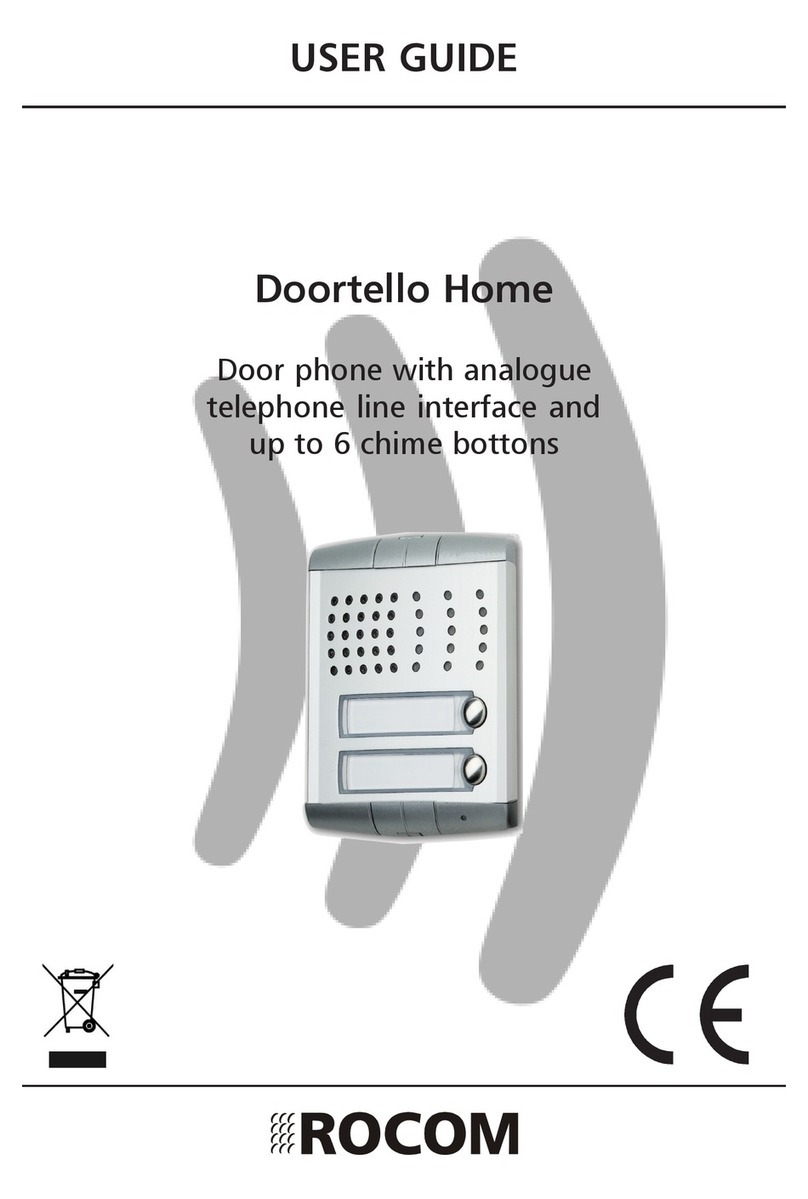
Rocom
Rocom Doortello Home User manual
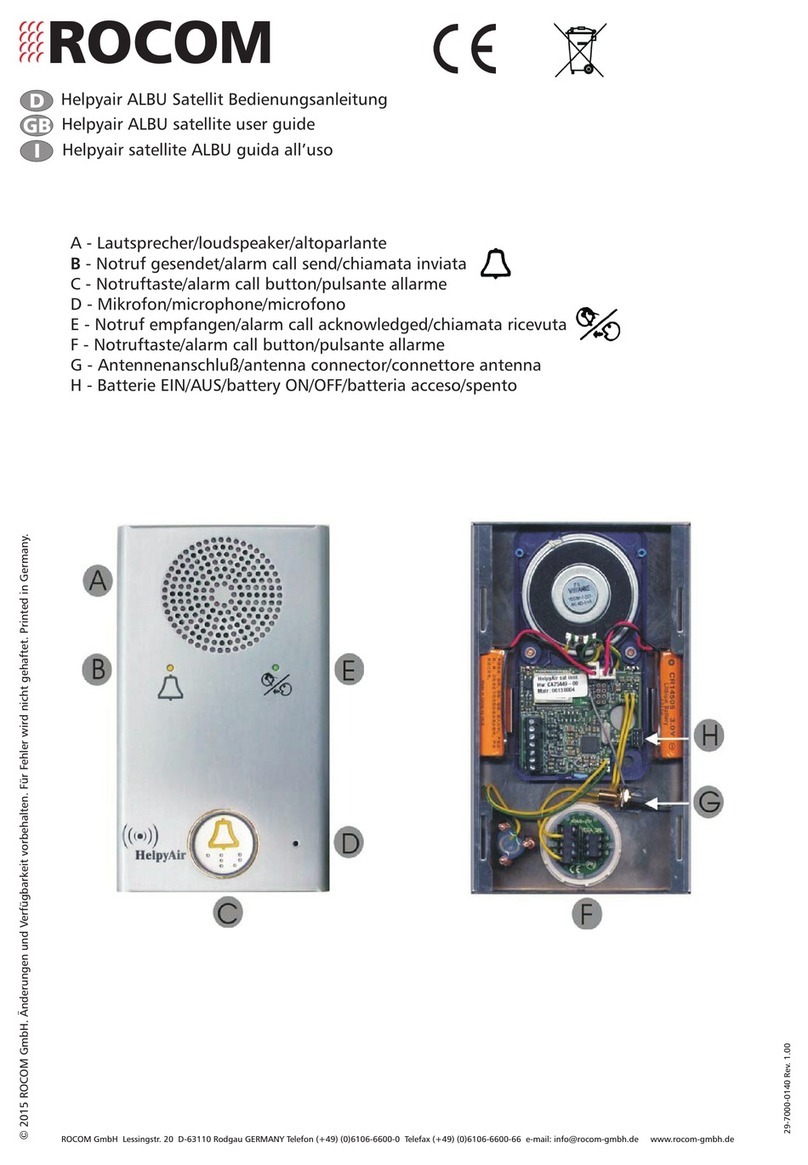
Rocom
Rocom Helpyair ALBU User manual
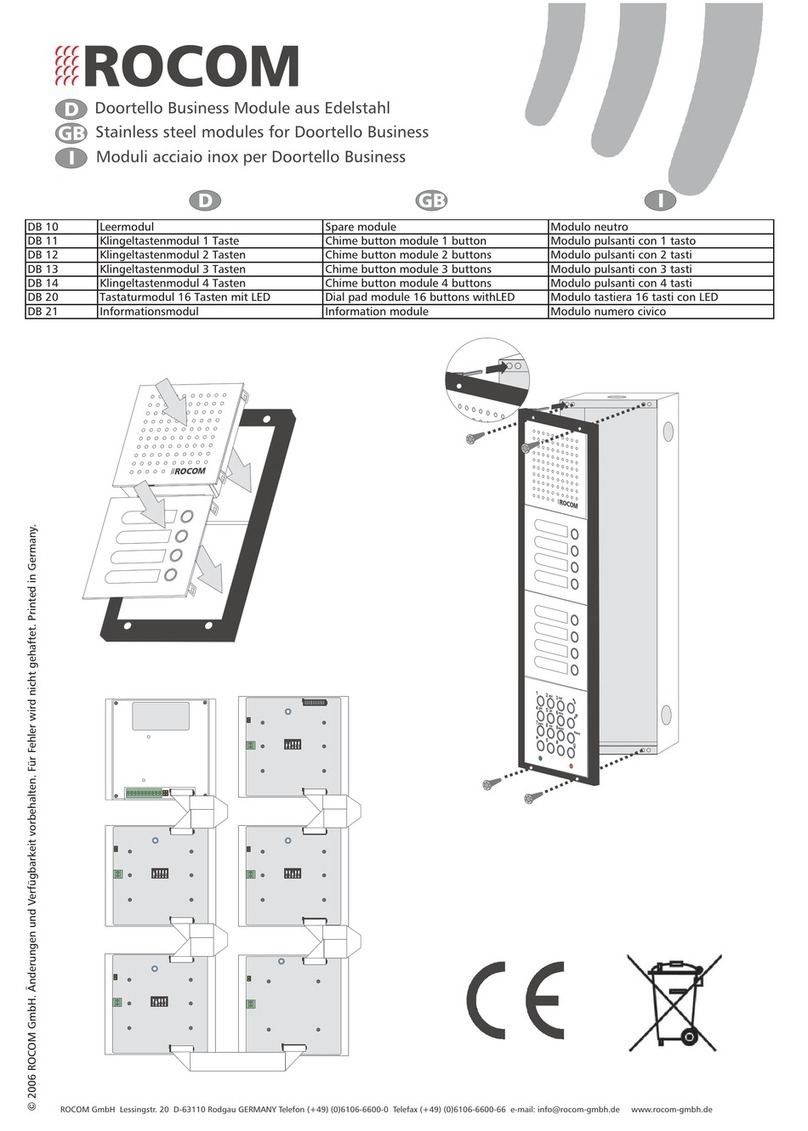
Rocom
Rocom Doortello Business DB 10 User manual
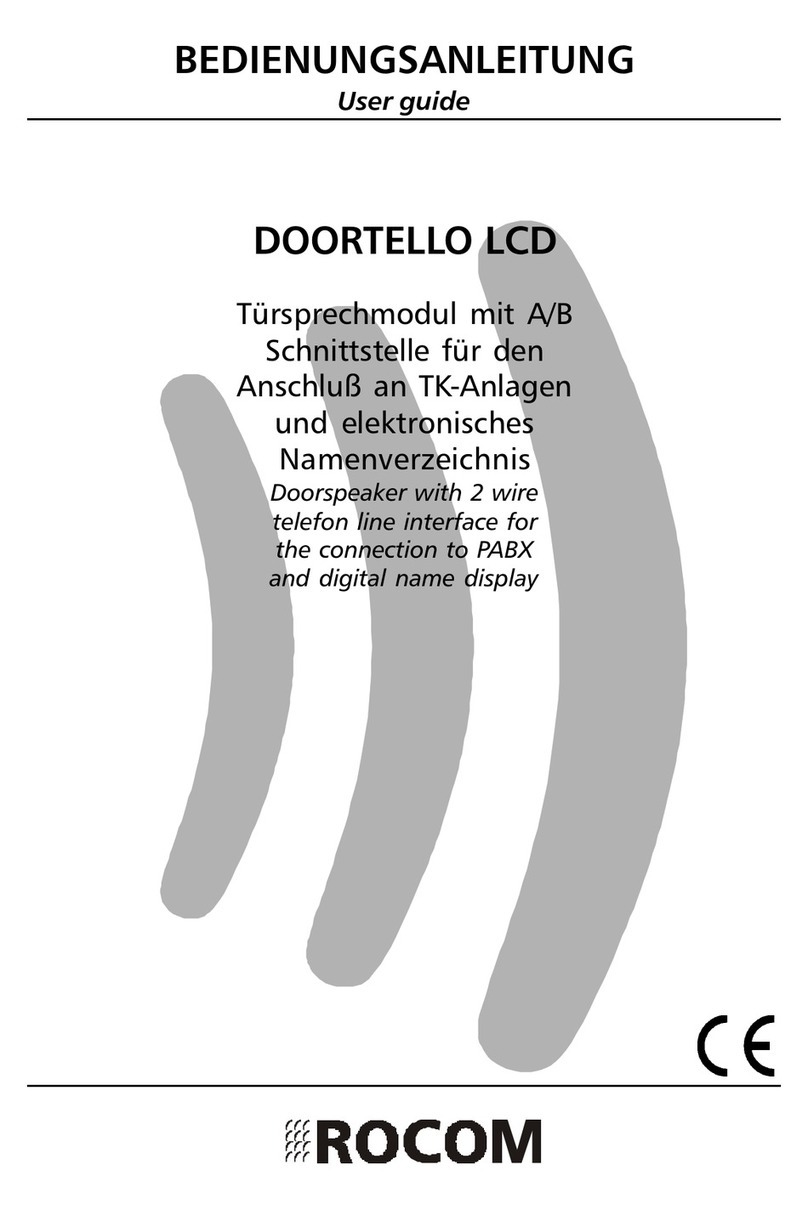
Rocom
Rocom DOORTELLO LCD User manual
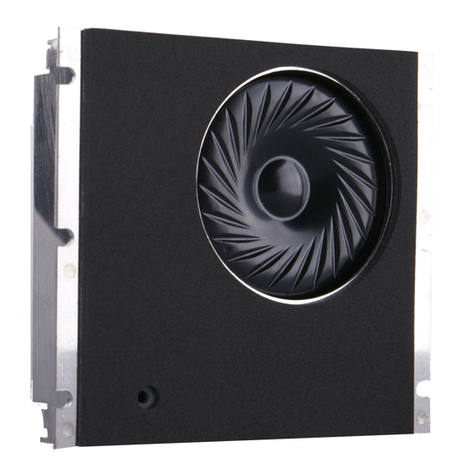
Rocom
Rocom Doortello Smart SIP BG User manual
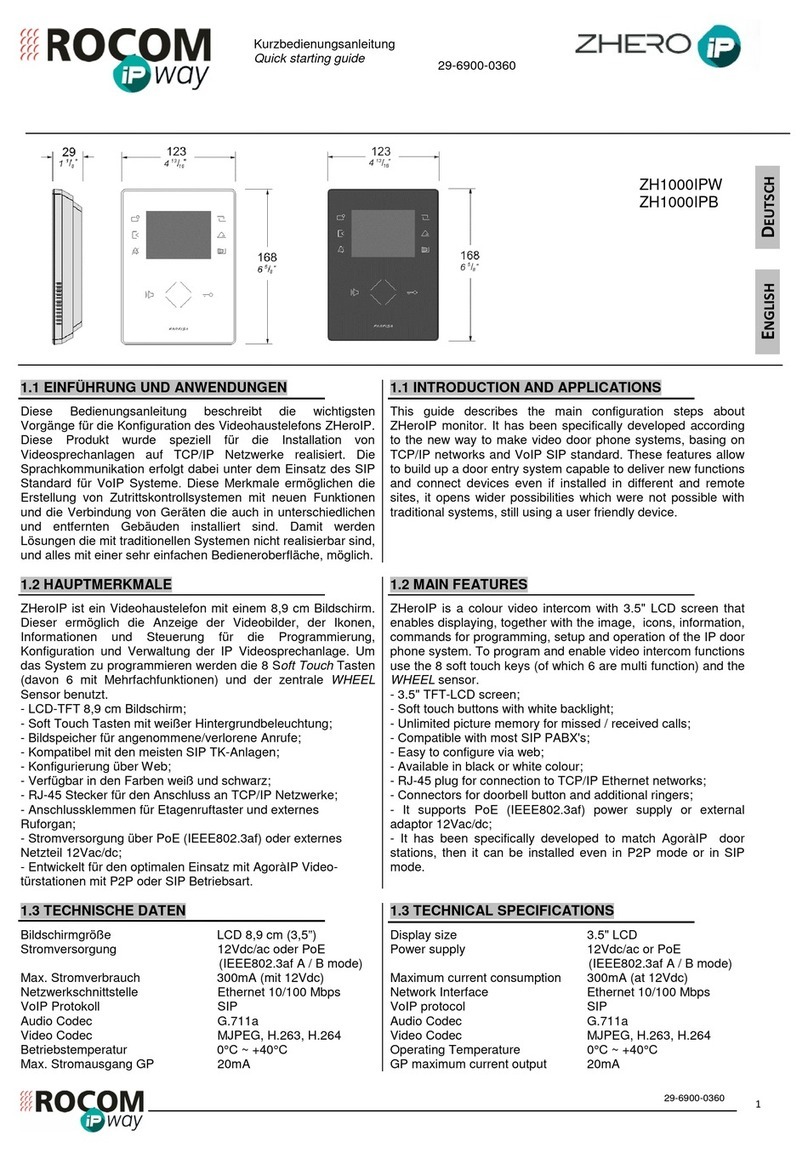
Rocom
Rocom ZHeroIP Series How to use
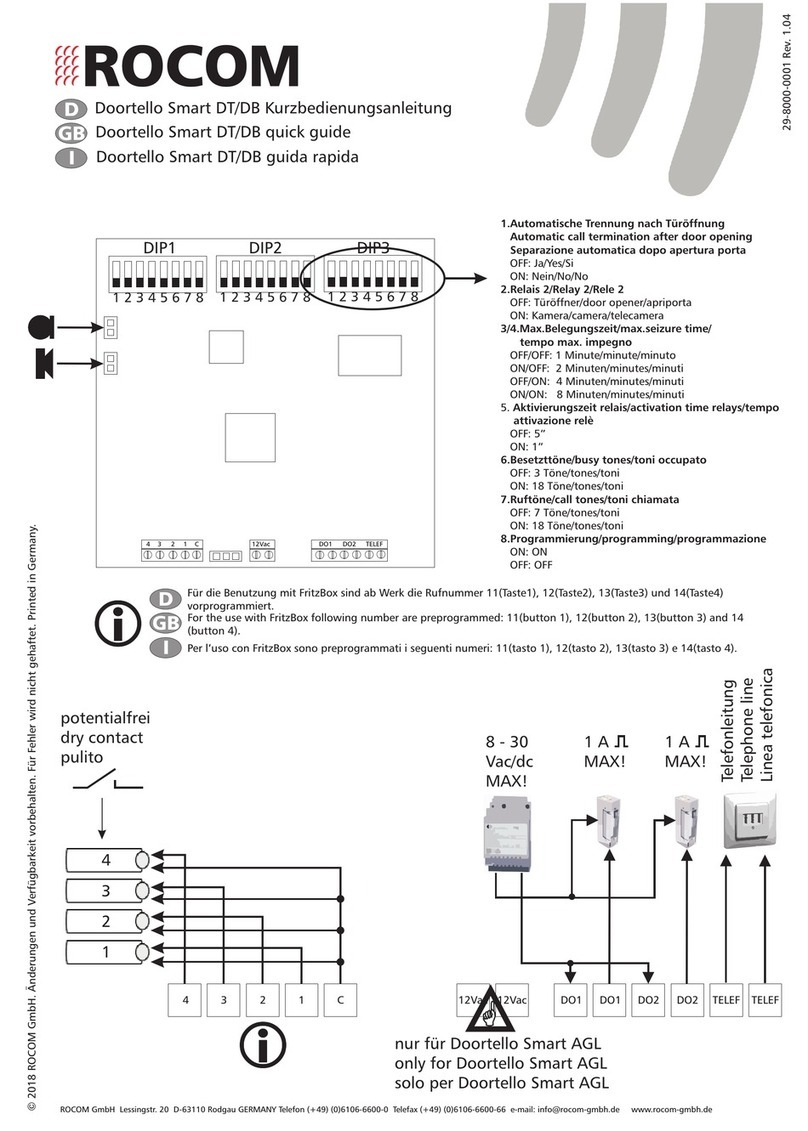
Rocom
Rocom Doortello Smart DB User manual
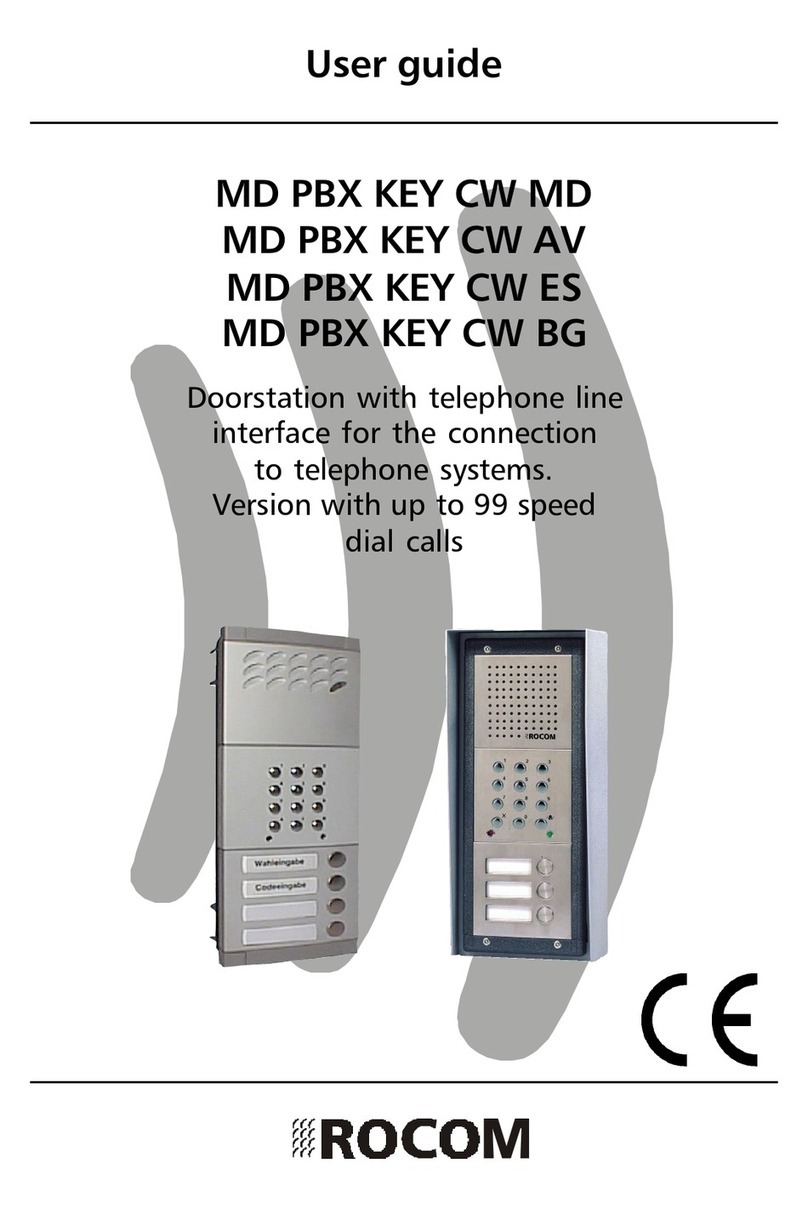
Rocom
Rocom MD PBX KEY CW MD User manual
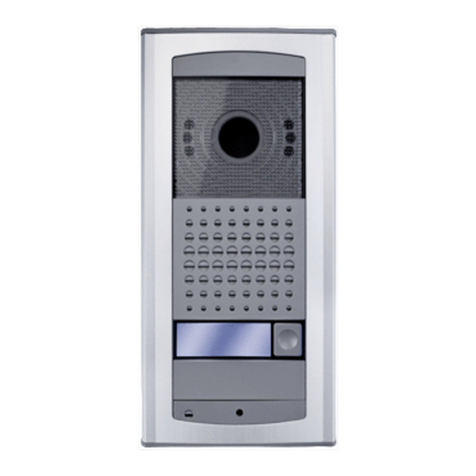
Rocom
Rocom Agora IP User manual
